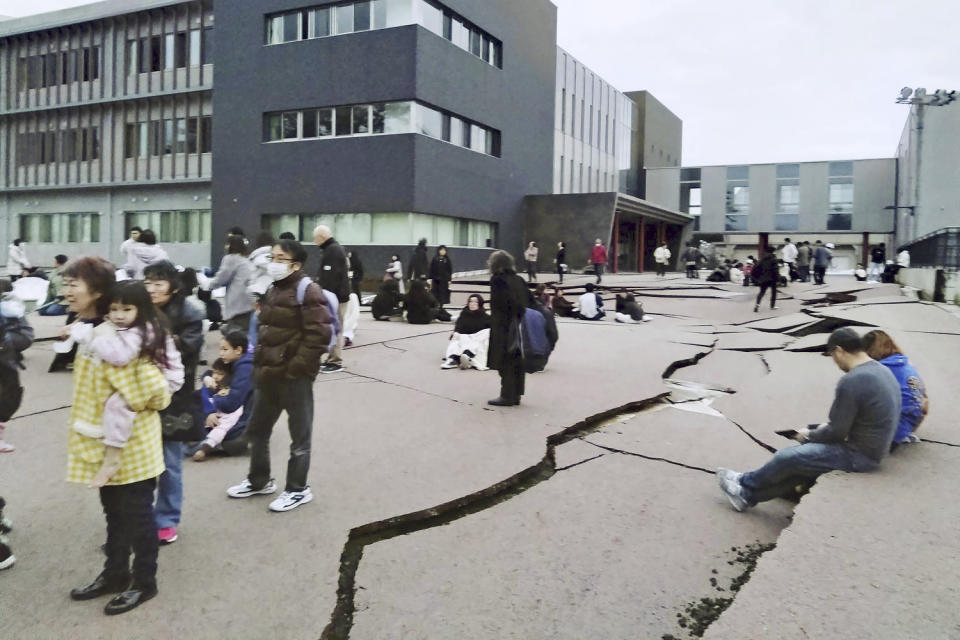Japan reports dozens of fatalities after series of strong earthquakes
- Oops!Something went wrong.Please try again later.
TOKYO — Japan was struck by a series of powerful earthquakes on New Year's Day that killed at least 48 people, reduced hundreds of buildings to rubble, and forced tens of thousands to flee to higher ground.
Dozens of survivors were being treated at hospitals across the Ishikawa prefecture and the emergency rooms were expected to become even more crowded as rescue crews free people believed to be still trapped in the ruins of homes and buildings.
The Japanese public broadcaster NHK TV summed-up the situation with a grim headline: "Homes have collapsed, there are people unconscious."
Potentially complicating the rescue efforts was a forecast that could include snow Tuesday in this region some 325 miles west of Tokyo, and the fact that so many roads have been damaged that manpower and supplies may have to be delivered by boat.
Meanwhile, firefighters were battling blazes that devoured some 50 buildings in a market area within the city of Wajima, NHK reported, citing Ishikawa officials.
Those buildings were believed to be largely unoccupied when, according to the Japan Meteorological Agency, the quakes hit off the Ishikawa coast a little after 4 p.m. local time (2 a.m. ET), with one reaching a magnitude of 7.6.
Japanese Prime Minister Fumio Kishida told reporters he would personally lead the nation's disaster response and has already been in touch with the mayors of Wajima and Suzu, which is another city on the Noto Peninsula hit hard by the quakes.
Not long after, the White House issued a statement pledging to help Japan if needed.
"My administration is in touch with Japanese officials, and the United States stands ready to provide any necessary assistance for the Japanese people," President Joe Biden said.
So far, three of the reported deaths — two in Nanao City and one in Shika Town — were due to building collapses, Japanese broadcaster NTV reported, citing information from local police. Eight people were confirmed dead and seven people were seriously injured in Wajima city, according to NHK. The two other deaths were reported in unspecified locations.

Kishida said search-and-rescue teams have been dispatched to the stricken cities, but manpower and supplies might have to be brought in by boat because many roads in the area are damaged.
Also, large swaths of the area were without power, water or cellphone service as a result of the quakes, Kishida said.
“As the casualties are starting to become apparent, it is now a race against time," Kishida said at a news conference. "We must work on rescuing everyone, especially those buried under collapsed buildings. I call on all to utilize all available methods, including deploying the Self-Defense Force, and to do everything possible to expedite the recovery and repair of damaged infrastructure as soon as possible.”
Tsunami warnings had been issued in the wake of the quakes in Ishikawa as well as the coastal prefectures of Niigata and Toyama, where 33,000 buildings had lost power as of 6 p.m. (4 a.m. ET), according to the Hokuriku Electric Power company.
The Japanese public broadcaster NHK TV warned the quakes could churn-up 17-foot tall waves and urged people on the entire west coast to evacuate.
Those tsunami warnings were lifted later Monday and, thus far, the tallest wave reported was around 4 feet tall and detected at the port in the city of Wajima, the broadcaster reported.

The quakes were so powerful they were felt on the other side of the country in Tokyo, according to the broadcaster.
A video posted to X showed a train station in Kanazawa, the capital of Ishikawa Prefecture, shaking and losing power during an earthquake. Another showed a family clinging on to whatever they could as their apartment in Kanazawa rocked wildly.
金沢駅!!!!!
つぶれかけました!!!!!
危険!!!!! pic.twitter.com/NFNPcB9LvW— 華めだか大阪 (@_gingiraginchan) January 1, 2024
Other videos posted to social media showed houses in some areas with roofs caved in and door frames falling off while surrounding trees fall to the ground. In some supermarkets, goods were scattered as the ground shook.
In Wajima, the quake flattened a lacquerware company and at least 30 homes in the city, trapping dozens of people under the rubble, NHK reported, citing the local fire department and a statement from the local government.
Several people with minor head or other injuries from falling objects were treated at Wajima Municipal Hospital, officials there said.
In Nanao City, which is located on the same peninsula, landslides, cracked roads, and collapsed homes were also reported, local police said.

In Suzu, the collapse of a two-story house was caught on camera by an NHK crew. Other footage showed one large isolated wave crashing off the coast of the city.
Earlier, Japanese officials announced it was sending military assistance to the hardest-hit areas but none of the nuclear reactors operating in the region had been damaged.
Train service in and out of the area was suspended and the airport that serves the cities on the Noto Peninsula was shut down.
Arata Yamamoto reported from Tokyo, Larissa Gao reported from Hong Kong, and Corky Siemaszko from New York City.
This article was originally published on NBCNews.com

